April 6, 2007
Air Date: April 6, 2007
FULL SHOW
SEGMENTS
Bench Press
View the page for this story
The Supreme Court of the United States recently ruled against the Environmental Protection Agency in the case Massachusetts vs. the EPA. In a 5-4 split, the court agreed with Massachusetts that the EPA has the authority to regulate carbon dioxide as a harmful pollutant under the Clean Air Act. Host Steve Curwood speaks with Georgetown law professor Lisa Heinzerling about the significance of the case. (05:30)
Court Catalyzes Climate Action
/ Jeff YoungView the page for this story
The nation's highest court handed environmentalists a historic victory, telling the EPA it can regulate greenhouse gas pollution. What will that mean for efforts to curb global warming? Living on Earth's Jeff Young reports the Supreme Court's decision is already making waves in industry and on Capitol Hill. (06:00)
Neighbors and Volunteers
/ Ingrid LobetView the page for this story
Many New Orleans residents are frustrated by a lack of state and federal help for rebuilding. But that's not stopping neighbors from organizing on their own. They're getting significant help from thousands of volunteers, brought in by faith groups and other non-profits. Living on Earth’s Ingrid Lobet reports that much of the progress made in post-Katrina New Orleans is thanks to this collaboration among neighbors, non-profits and volunteers. (18:00)
International Climate Report Reveals World Vulnerabilities
View the page for this story
The Intergovernmental Panel on Climate Change released the results of its second Working Group this past week. The group's report focused on the impacts of global warming and adaptation to the changing climate. Host Steve Curwood talks with Jeffrey Sachs, director of the Earth Institute at Columbia University, about some of the larger conflicts that may arise as a result of climate change. (07:15)
Sonic Sculptures
View the page for this story
Doves cooing, juniper branches crackling, wind blowing through the holes of a dead cactus. These are some of the sounds that artist Steve Peters recorded at an outdoor art space in New Mexico. Peters transformed the sound into an installation called “Hereings” in 2002. Paul Ingles produced the story for Living on Earth and it won an Edward R. Murrow Award for best use of sound. Here’s a re-broadcast of the piece and a followup with sonic sculptor Steve Peters to see, or shall we say hear, what he’s now working on. (09:00)
This week's EarthEar selection
listen /
download
Take a walk through the sound side.
Show Credits and Funders
Show Transcript
HOST: Steve Curwood
GUEST: Lisa Heinzerling, Steve Peters, Jeffrey Sachs
REPORTER: Paul Ingles, Ingrid Lobet, Jeff Young
[THEME]
CURWOOD: From Public Radio International - this is Living on Earth.
[THEME]
CUWOOD: I’m Steve Curwood. By an historic, five to four vote the US Supreme Court puts the federal government on notice to begin regulating the global warming gas CO2.
Environmental advocates and industry lobbyists agree that the ruling is a major turning point in the fight over climate change.
SEGAL: The fact that the court asserted its jurisdiction in a global climate case and allowed standing of the petitioner in the case is very significant. And for people in industry to say it’s not, they’re probably gilding the lily a little bit.
CURWOOD: Also, warnings that climate change will especially hurt the poor and promote widespread conflict.
SACHS: It's known statistically quite powerfully we see it before our eyes in the case of, ah, Darfur and the horn of Africa, that when the rains fail, the wars come.
CURWOOD: That and more this week on Living on Earth. Stick around!
[MUSIC: Boards of Canada “Zoetrope” from ‘In A Beautiful Place Out in the Country’ (Warp Records – 2000)]
[NPR NEWSCAST]
ANNOUNCER: Support for Living on Earth comes from the National Science Foundation and Stonyfield Farm.
[THEME]
Bench Press
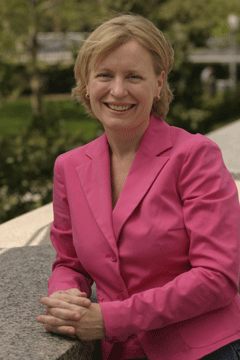
Lisa Heinzerling (Courtesy of Georgetown University Law Center)
CURWOOD: From the Jennifer and Ted Stanley Studios in Somerville, Massachusetts - this is Living on Earth. I’m Steve Curwood. On April 2nd the Supreme Court of the United States ordered in effect that the federal government must join the rest of the world’s major industrialized nations and take control of emissions of the global warming gas, carbon dioxide. The case of Massachusetts versus EPA had its origins in the Clinton Administration, but the Bush Administration had been steadfast in refusing to regulate CO2. By a 5-4 vote high court ruled the EPA’s refusal to act was arbitrary and capricious.
Among other things, the government had argued that regulating global warming gases might put the US at a disadvantage in climate negotiations with developing nations. This drew some of the sharpest language in the majority opinion. Justice John Paul Stevens wrote: “While the President has broad authority in foreign affairs, that authority does not extend to the refusal to execute domestic laws.”
In a few minutes we’ll explore the impact of the Supreme Court ruling. But we begin our coverage by turning to the lawyer who wrote the brief for the lead plaintiff in the case. Lisa Heinzerling is a professor of law at Georgetown University Law Center.
Hello, Professor.
HEINZERLING: Hello
CURWOOD: So, how big a deal is this Supreme Court decision regarding Massachusetts versus the EPA?
HEINZERLING: I think it’s really one of the biggest environmental cases the Supreme Court has decided. If you look just at the magnitude of the problem that’s under consideration; climate change, you can’t get any bigger than that. On every single issue we won and I think we won big: on standing, on the EPA’s authority to regulate greenhouse gases, on its discretion to refuse to regulate. On every one of those issues we had to win, we did win, and the Supreme Court wrote a very broad opinion on each of those issues.
CURWOOD: Now, as I understand it- and I’m not a lawyer- the biggest part of this case was something called standing, that is, the right of people to sue. What is that and how did this case come down on this question of standing?
HEINZERLING: Standing is sort of short hand for the kind of injury that you have to have in order to get into Federal court. So the court says that you have to be what they call “injured in fact.” You have to suffer some kind of injury in order to bring a claim in Federal court. The court also says that you need to show that whatever violation of law you’ve asserted is connected to your injury, your injury is caused by that violation of law. And then third you have to show that judicial redress will help solve your problem. And on each of these three counts the court ruled in our favor.

Lisa Heinzerling (Courtesy of Georgetown University Law Center)
CURWOOD: How was it that Massachusetts was able to claim injury from carbon dioxide?
HEINZERLING: We argued that Massachusetts had already lost some portion of its territory due to rising sea levels.
CURWOOD: So what was the argument against this? What was it that the Bush Administration said people weren’t being injured by this or the courts wouldn’t deal with this?
HEINZERLING: The government said that automobiles, which are the subject of this case, contribute too small a portion of the problem of climate change to show either that our problem was caused by EPA’s refusal to act on climate change or to show that any judicial recovery would help us. So they said it’s just too little a piece of the problem in order to get into Federal court. And the Supreme Court really resoundingly defeated that argument and said that even if you solve a problem to some extent that’s enough to get into Federal court you don’t have to show that this solution will be everything or even most of a solution but just that it will solve it to some extent.
CURWOOD: Now Massachusetts is the first name on the case but California has been much involved in this and in fact has some important rules regarding automobile emissions and carbon dioxide that have been held at abeyance pending this case. So explain for me a bit more about the California cases and the standards that are involved here.
HEINZERLING: California has asked EPA to permit it to set its own standards for automobiles. And ten states have said that they would like to set California standards for automobiles for their own fleets.
CURWOOD: And this has gone on for years.
HEINZERLING: Yes.
CURWOOD: I mean for a long time California’s been able to have its own air pollution standards.
HEINZERLING: Absolutely it’s been really since day one under the Clean Air Act. California has been allowed to set its own standards and for a very long time states have been allowed to opt in to those standards.
CURWOOD: Ok
HEINZERLING: And so the question really is may California do that? And if you look at the statutory requirements once EPA has, as it has with this decision, been given authority to regulate greenhouse gasses it seems to me quite easy to conclude that California’s standards should be approved.
CURWOOD: And of course, California wants to limit greenhouse gasses coming from cars, which essentially means they’re going to have to get better mileage.
HEINZERLING: Yes.
CURWOOD: The legal system takes a long time to get things done. This case was based on an action brought by groups in 1998. Here it is almost nine years later that we get a clear statement from the Supreme Court of the United States that the EPA must regulate the principle human-caused greenhouse gas. How much does it trouble you as a lawyer that it can take so long to get a critical issue addressed?
HEINZERLING: It is terrible that it takes this long. It took the EPA from 1999 to 2003 simply to answer the petition to regulate greenhouse gasses. And then it took all of this time for the case to make its way through the courts. It’s a terrible way to proceed. It would be much better if an agency like the EPA simply looked at its authority, looked at the world around it, saw a significant problem which is climate change and then did its job without being forced to do its job by the courts. That would be much better, much more efficient. I think everyone would be benefited.
CURWOOD: Lisa Heinzerling is a professor of law at Georgetown University Law Center. She wrote the Supreme Court briefs on behalf of the plaintiffs in the case Massachusetts vs. EPA. Thank you.
HEINZERLING: Thank you.
Related links:
- Supreme Court Decision
- Georgetown Law Panel on the Court's Decision
Court Catalyzes Climate Action
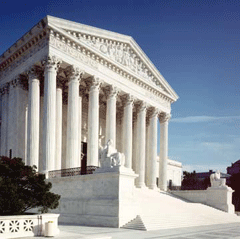
The U.S. Supreme Court (Courtesy of U.S. Supreme Court)
CURWOOD: The impact of the high court ruling is already being felt. On Capitol Hill it’s changing the debate on climate action and the EPA almost immediately started a long-delayed process to allow California to regulate CO2 emissions from cars. That move would permit other states to adopt the restrictions as well.
Here’s Living on Earth’s Jeff Young.
YOUNG: Sierra club attorney David Bookbinder worked years on the climate change case Massachusetts versus EPA. You might think that after his side won in the Supreme Court he’d take a day to celebrate. No such luck.
BOOKBINDER: It felt really good until we started having to do all the follow up work.
YOUNG: Twenty-four hours after the decision Bookbinder was packing legal briefs for a trip to Vermont, where he’ll put the high court ruling right to work. Vermont is among ten states joining California’s effort to limit the greenhouse gases coming from cars and trucks. The auto industry sued to stop them and the Vermont case is the first to go to trial. Automakers argued that if EPA lacked authority to regulate greenhouse gas emissions, the states couldn’t do it either. Now that five Justices say EPA does, in fact, have authority Bookbinder expects the other auto cases to take the same road.
BOOKBINDER: We believe those courts will now wind up dismissing the auto industry claims.
YOUNG: That shows how immediate and profound the high court decision could be in the climate change debate—and it doesn’t stop with tailpipes. The high court case dealt with auto emissions but Georgetown environmental law professor Richard Lazarus says the same legal argument could easily apply to stationary sources like power plants.

The U.S. Supreme Court (Courtesy of U.S. Supreme Court)
LAZARUS: This case has a really wide sweep, the Massachusetts versus EPA. This case establishes that greenhouse gases are air pollutants for the purposes of motor vehicles. There’s no light between that issue and whether they are air pollutants for major stationary sources under the Clean Air Act.
YOUNG: Together, autos and power plants account for more than 60 percent of US greenhouse gas emissions. Lazarus calls the high court’s climate decision historic. And he notes it wasn’t the only environmental victory from the court. In a second decision issued at the same time, Justices unanimously upheld something called New Source Review. That important enforcement tool in the Clean Air Act requires power plants to add pollution controls when they expand their capacity. In both cases, arguments favorable to industry had won in the lower courts. Lazarus says the Supreme Court’s decision to even consider those cases was unprecedented.
LAZARUS: This was the first time the court decided any case, let alone two cases, in which environmentalists sought Supreme Court review from a loss. That hasn’t happened once before let alone twice before. I kind of view it from the environmental world the equivalent of winning two national championships in one day.
YOUNG: The mood was more somber across town on K Street, where industry attorney Scott Segal also turned to a sports metaphor to sum up his reaction.
SEGAL: Ah, there’s no joy in legal Mudville for industry today.
YOUNG: Segal represents refineries, power companies and other energy interests at the firm Bracewell and Giuliani. He’s bothered by the part of the court’s decision that deals with standing—that’s the term for the right to bring a claim in federal court. Justice Stevens’ opinion opens the courthouse door a bit wider for global warming suits. That could spell trouble for power plants and other greenhouse gas emitters seeking permits for new facilities.
SEGAL: The fact that the court asserted its jurisdiction in a global climate case and accepted the standing of the petitioner in the case is very significant. And for people in industry who say that it’s not, they’re probably gilding the lily a bit. Lawyers representing industry are thinking very hard about what the impact might be for stationary sources and they would be well advised to do so.
YOUNG: The Justice’s decision could have an even greater impact in Congress, where the Democratic leadership is considering several climate change proposals. New Mexico Democrat Jeff Bingaman chairs the Senate’s Energy committee.
BINGAMAN: Now that it’s clear EPA not only has the authority but is really under an obligation to step up and regulate greenhouse gas emissions if Congress does not act, I think it does put additional pressure on Congress to act.
YOUNG: Bingaman says many members of Congress prefer a comprehensive climate change bill with a cap and trade system. He says that would be more cost effective global warming policy than a simple regulation by EPA. But any such bill still faces opposition at the other end of Pennsylvania Avenue. At a White House press conference the day after the high court’s ruling, President Bush restated his objections. He says a cap on US emissions would hurt the economy while leaving other countries free to pollute.
BUSH: We could pass any number of measures that are now being discussed in the Congress, but unless there is an accord with China, China will produce greenhouse gases that will offset anything we do.
YOUNG: The high court’s decision acts like a catalyst speeding up the climate change debate already underway. It emboldens states and environmental groups to act at the local level, which in turn, puts more pressure on Congress to come up with a national policy. And that could force a global warming showdown with the White House.
For Living on Earth I’m Jeff Young in Washington.
CURWOOD: Later in the program, we’ll hear how the newest scientific assessment points to a rising risk of conflict related to global warming. Stay tuned to Living on Earth.
[MUSIC: The Slip “Tinderbox” from ‘Angels Come on Time’ (Rykodisc - 2002)]
Related links:
- The Supreme Court opinion in Massachusetts v. EPA
- The Supreme Court opinion in Environmental Defense v. Duke
- Georgetown Law Center's overview of climate change cases in the courts
Neighbors and Volunteers
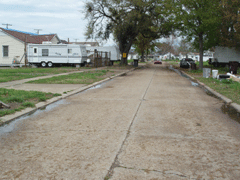
A year and a half later, people are still living in FEMA trailers, not their homes. Chalmette, St Bernard Parish, La. (Photo: Ingrid Lobet)
CURWOOD: It’s Living on Earth. I’m Steve Curwood. Hurricane forecasters are predicting that 2007 will once again be a big year for storms. They’re projecting nine hurricanes, including five of at least category three strength, akin to the blockbusters of 2004 and 2005. Of course there were similar predictions for last year, which did not materialize, likely due to the dampening effect on storms of the El Nino weather system.
The prospect that another major hurricane could come ashore in the US this year can hardly bring comfort to the people in the Gulf Coast region, who were savaged by Hurricanes Katrina and Rita in 2005. Today, 18 months after the storms, many New Orleaneans still live in 240 square feet of space—that is, in FEMA trailers, in their own driveways, next to bare foundations or the gutted frames of their former homes.
And many city residents are frustrated. They’re fed up with struggling to get loans and grants to rebuild their houses. But neighbors are still helping neighbors. And they’re being helped in turn by a remarkable flow of young volunteers still streaming in from around the country. Living On Earth’s Ingrid Lobet reports from New Orleans.
LOBET: This neighborhood in New Orleans East is a stretch of tidy post-war homes with front yards mostly still bare after their saltwater soaking by Lake Pontchatrain, a couple of blocks up the road. The white rear-ends of a few FEMA trailers butt out into driveways.
RUSSELL: But a few months ago there were more trailers than this. There were really more trailers than this. The majority of our trailers are leaving. That’s a good sign.

A year and a half later, people are still living in FEMA trailers, not their homes. (Chalmette, St Bernard Parish, La.) (Photo: Ingrid Lobet)
LOBET: Tangy Russell keeps vigil over her neighborhood by day. At night, when she’s at work at the Post Office, her neighbors keep watch. Determined to stay connected after the storm, somehow, together, they’ve created the certainty for each other to return.
RUSSELL: One of them found out that most our neighbors were coming back. So one told the other and then word spreaded out that the majority was coming back. That gave us the green light to go ahead and start redoing our houses.
Heyyyyyyy!! She’s one of our workers with Energy, but she lives down the street too.
LOBET: These neighbors mow the lawns of the few houses still vacant.
RUSSELL: Basically if I need help with roofing or something I’ll call one of the guys and he’ll come. So we pretty much help each other out. Because have a neighbor down there, he’s in Iraq right now. We keep in touch with him. He calls us once a month and let’s us know he’s okay. So once we get everybody back, we’re going to have a seafood broil in the neighborhood.
LOBET: And today is another advance toward that date, because the house across from Russell’s, vacant for so long, is finally getting its guts removed.
[SMASHING SOUND]
LOBET: A group of students from the College of Wooster in Ohio wear white Tyvek suits, smash through drywall and shovel it out onto the curb. On top of a little pile the students have set aside is a card that says “Mom you are valued, you are needed, you are loved.”
Inside, the walls were once light blue. Now, a fierce black mold populates the walls up to a perfect line at about three feet: the line where water sat. The splotchy mass is nearly a quarter-inch thick in some places.
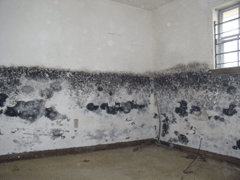
Mold reveals the water line in New Orleans East. (Photo: Ingrid Lobet)
MALE STUDENT VOLUNTEER: Whistle. Hey where the keys at to the blue van?
LOBET: A few hours later, the house is gutted and some students move on to the next house.
These volunteers and thousands of others are a feature of today’s New Orleans. They come from all over the country, in wave after wave, organized by student associations, church youth groups, young activists.
[SOUND OF A YOUNG CROWD]
On any given morning, you can find a newly-arrived group getting orientation, as here at Louisiana United Methodist Storm Recovery.
WOMAN: We have one of New Orleans’ finest (clapping). This is Sergeant Favoloro. He’s going to talk to you about safety while you’re here this week.
FAVOLORO: I’m John Favoloro I’m assigned to the 6th district. This area round here, I’m not going to lie to you, is one of the hottest areas we have. Just around the corner the other day we had a drive-by shootin’. All our shootings up here are dope dealers. They shootin’ each other. We had three of ‘em Saturday. But while you’re up here, be careful. You ladies like to shop they got all kind of blue jeans places, used blue jeans and everything else. But around here don’t go roamin’ at night. When you all do these houses, pay attention what you doing, we been having a lot of trouble with spiders, a couple of policemen got bit. Make sure it’s well-lit. And that’s all I gotta tell you.
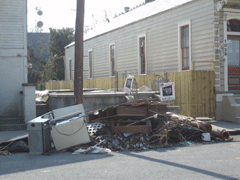
An owner tries to sell a lot with only a bare foundation. The remains of the house lie in front. (Photo: Ingrid Lobet)
MALE VOLUNTEER: Sir?
FAVOLORO: Uh huh?
MALE VOLUNTEER: What kind of spiders was it?
FAVOLORO: The brown recluse.
[AUDIENCE GASPS]
FAVOLORO: But y’all be careful out there. And thank y’all. We really do appreciate it. Because if it wasn’t for y’all, we would be in deep trouble. And thank y’all from the people of New Orleans.
[CLAPPING]
LOBET: The owners of the houses where the volunteers will work may be elderly, disabled, for some reason unable to do the tear-out on their homes. Recovery center staffer Shawn Darnell reminds the volunteers to be compassionate about what that person may have been through.
DARNALL: You may look at something and say this is not worth saving. Why does she want to keep this?
LOBET: Darnall tells them to collect any papers that could be used for identity theft. The volunteers’ work will enable the crucial next step, treating the framing for mold.
DARNALL: Your goal when you walk out of that house is to have nothing but the exterior walls and the studs showing.
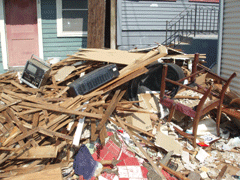
A common sight in New Orleans a year and a half after Hurricane Katrina. (Photo: Ingrid Lobet)
[SOUND OF METAL TOOLS CLANKING]
VOLUNTEER COORDINATOR: You got kneepads, crowbars, small sledges.
LOBET: And with that, volunteers collect hand tools and fan out across the city to their assignments. Shawn Darnall sits down for a minute to breathe, between back-to-back orientations.
DARNALL: I think our Baton Rouge headquarters told us we would see over 3000 volunteers for the month of March. We have no more housing for the month of March.
LOBET: Since the storms, she estimates her group has brought in 25,000 people. That’s just United Methodist efforts. It doesn’t count Habitat for Humanity or Catholic Charities or other large non-profits.
DARNALL: I have been surprised by the response 18 months later. Because all the experts told us after the first year it is going to decrease drastically. And we have more volunteers here than we’ve ever had before, by double. We know that this summer, we have another very big influx of volunteers. It’s amazing.
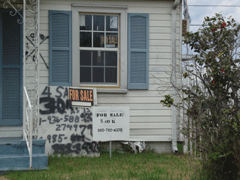
An owner tries to sell a home in Chalmette, St. Bernard Parish, La. (Photo: Ingrid Lobet)
LOBET: People like Darnall who direct these scores of volunteers are disaster victims themselves. They haul themselves out of bed in the morning, and face personal restoration while they try to raise up their city.
DARNALL: My house was okay but Katrina has torn my family apart. My husband is working in California and has been there for a year now and we don’t have an end in sight.
LOBET: Only half as many people live in the city as before. Half a population means half an economy. Darnall’s husband works for Southwest Airlines, which offered to keep its employees on if they would relocate somewhere people were still going. The family’s best compromise on income, stability and school left their eight-year-old son Colton living away from his Dad.
DARNALL: And there is despair still and the devastation. Certain areas of the city you look around and it is a ghost town. The frustration with even now, 18 months later, going to the grocery store and there not being any eggs, because they might be delivered, but they don’t have the staff to get them out. Just living here on a day-to- day basis can be nerve-wracking.
LOBET: She worries about her son.
DARNALL: That is my fear as a mother, that he grows up and eight to ten years from now and he says my life was normal until Katrina.
[SOUND OF CHILDREN]
LOBET: After a day of often physical work, the volunteers return to wherever they’re camped, in this case Carrollton United Methodist Church. The stately building is showing some wear; it’s been given over to need.
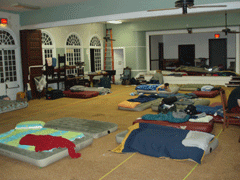
Volunteers from all over the country share a church floor for the night. (Photo: Ingrid Lobet)
MARSHALL: The lady’s house we worked on, she hasn’t been seen since the storm and they just put a note up on her house.
MISSEN: And she’s an old lady and she’s in a wheel chair and they expect her to just come clean all this up. I was disgusted. I was just like, how can you do this to your own people?
MARSHALL: They don’t even have power yet.
STAVELY: These are people who had to work for what they have and they were proud of what they had.
LOBET: The loss leaves a powerful impression on Mike and Eve.
MISSEN: Like a lot of it is just clear and like overgrown, but you can still see the bare foundations and you just realize how many houses were ripped up and destroyed.
STAVELY: They’ll never forget the memories. Going on a tour today, she can point out, that open lot was so-and-so’s house and she knew who lived there.
MISSEN: Like there’s just one spot where all the oak trees had like overgrown into a canopy, and she said the whole street had been like that. At the end there were just four trees like that. It was just sad to see how much has been destroyed.
LOBET: Everywhere they go, Anna Kann says, they encounter gratitude.
KANN: Just random people in the street will tell us they are happy we are here and it makes me feel really good but I just want them to get their houses back.
LOBET: Several kids say they felt misled by media coverage. “How could I not know the number of people who died in these storms?” Abi Marshall asked.
MARSHALL: I feel like you shouldn’t have to come here to know the damage that’s been done and you shouldn’t have to come here to like see what’s happened. There is so much that went on that I feel like I would never have known if I hadn’t come here, it’s been a huge eye-opener, I know now I can’t take things at face value.
LOBET: Older students also said what they’d seen on TV did not prepare them for reality.
FITZGERALD: I’m Aaron Fitzgerald and I’m from Rhodes College in Memphis, Tennessee. When I came down here and I saw cars still flipped over, roofs just off of persons’ house. And today we gutted someone’s house and her floor - this was in the lower Ninth Ward - her floor was just completely still damp and I had to bring her inside and say “Do you want me to tear up your whole floor or do you want us to just leave the frame?” My friend Jamie fell through twice, I fell through once. It was awful.
LOBET: The trip, though, he says is worthwhile.
FITZGERALD: I recommend anyone to come down here because if you do, your life will be changed. I feel changed.
LOBET: Fitzgerald recounts that one of his group leaders marveled at the numbers of volunteers. But he was struck by something different.
FITZGERALD: I’m thinking in my head “We’re supposed to be a first world country and we still have others living in 3rd world poverty in our own country, in a city that is a major city.”
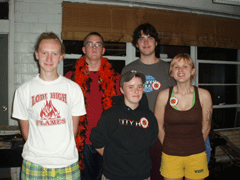
Iowa City high school students tore out overgrown brush and rebuilt a ballfield in New Orleans. (Photo: Ingrid Lobet)
LOBET: Still older students, law students, have formed their own Student Hurricane Network. Since the storms, the Network has brought down 2,700 law students to the Gulf Coast and organized others long distance. Lauren Bartlett is in her third year at American University.
BARTLETT: First of all I think there is a new generation of law students which are committed to public interest work, maybe even some who came to law school since the storms of 2005 for the particular purpose of being involved.
LOBET: Morgan Williams is co-founder of the Network and a third year student at Tulane. He says even though they’re students, not attorneys, and even though Louisiana Law is unique, the students can be extremely helpful.
WILLIAMS: Basically, in communities where homes have been handed down for generations and generations, folks at the time of the storm, might not have had the actual piece of paper that says they were the owner of that home. And when the home gets destroyed and everyone gets displaced, the state says we need that piece of paper. So because the federal funding that’s being administered through the state through the Road Home program is linked to having that piece of paper, they are being locked out from being able to receive those funds and being able to begin the process of rebuilding.
LOBET: Pro bono attorneys who can help people with these affidavits are so overwhelmed they can’t take more applications. Enter the law students. The teams are also carrying out a major survey of people who are still, this long after the storm, living in FEMA trailers.
BARTLETT: The residents living in trailers are the most forgotten, the most marginalized. There are a lot of needs, but we have to find out what those are before we can move.
WILLIAMS: It’s something that’s bringing the law students face to face with the realities of the rebuilding process, and the frustration and the anger people and the sources of those frustrations and anger that folks down here are really facing in their efforts to rebuild.
LOBET: Bartlett says she’s one of the law students whose life direction has been changed.
BARTLETT: When the storm hit, you know some things really touch you; in a way that you can’t use words to describe. And when the storm hit, I felt very connected and felt it really personal about it all. I started fundraising at my law school and having conferences, getting articles published, and came down and have been here every second of every day I could possibly spare since. I’m going to be moving down here in August. I want to live here.
[SOUND OF A MEETING]
LOBET: Every Tuesday night, people in the Holy Cross neighborhood in the Ninth Ward meet. They’ve met for years, but now their work is all strategy, related to rebuilding and protecting their historically rich and devastated neighborhood. They sort through bureaucratic and day-to-day hurdles.
WOMAN: And one guy said he had a building permit number but when he tried to get a building permit, they told him he had no building permit.
WOMAN2:I haven’t had a refrigerator since Thanksgiving
WOMAN3: Mine just broke down this weekend and everything in it spoiled.
LOBET: But that doesn’t mean there’s no progress. Residents make plans for opening a new store and donation center for green building materials. They applaud a group of first year medical students from Dartmouth who’ve stopped in. They’re helping rebuild a neighborhood clinic. And there’s a happy announcement, more people are coming back; the Post Office is delivering to 800 houses in the neighborhood, up from 200 a month and a half ago.
At the break, 77-year old Jeanne Lee stops to discuss how things are going with her property.
LEE: I was in the area on Monday getting my house gutted out. The houses are really coming back.
LOBET: Who was gutting your house out?
LEE: It was some volunteers from the University of New Hampshire. Very lovely young people. They worked very hard. They started about nine and worked until five in the evening—and the house was completely gutted.
LOBET: But when it comes to taking the next step, rebuilding, Lee, like so many people here, has been waiting for a letter that says she’ll get some State recovery help. It hasn’t arrived.
LEE: So now I have to go and make a loan if I want to repair the property. And at my advanced age I don’t know how that is going to work –that has me bothered.
LOBET: But Jeanne Lee made sure I knew, before the meeting resumed, that she plans to meet the challenges.
LEE: I’m 77 and I have not begun to fight. I’m going to fight to keep my house.
LOBET: The Holy Cross meeting adjourns; it’s late. Tonight, under roofs across the city, young volunteers will set out air mattresses, assimilate what they’ve seen, wash dishes together.
[SOUND OF DISHES]
VOLUNTEERS: (singing) If that ain’t love then I don’t know what love is. If I had to choose her or the sun…
LOBET: And in a too-quiet neighborhood elsewhere in the city, an ice cream man drives a distance before there’s someone to spend a dollar.
[SOUND OF ICE CREAM TRUCK]
LOBET: For Living On Earth, I’m Ingrid Lobet in New Orleans.
[MUSIC: The Dirty Dozen Brass Band “Amazing Grace” from ‘Funeral For A Friend’ (Rope-A-Dope Records - 2004)]
Related links:
- The Student Hurricane Network
- All Congregations Together
- A special edition in The Times-Picayune: "Last Chance"
- Greater New Orleans Community Data Center
- Help Holy Cross Neighborhood
- Center for Bioenvironmental Research at Tulane and Xavier Universities
- Louisiana Recovery Authority
- Louisiana United Methodist Disaster Recovery Ministry
- The Preservation Resource Center of New Orleans
- People's Organizing Committee
CURWOOD: You can find more of our coverage of the aftermath of Katrina on our website, LOE dot org. That's LOE dot O-R-G. And we’d love to hear your comments on the program. Send them to comments @ l-o-e dot org. That’s comments @ l-o-e dot O-R-G. Our postal address is 20 Holland Street, Somerville, Massachusetts, 02144. And you can call our listener line, at 800-218-9988. That's 800-218-99-88.
Just ahead: How global warming is raising concerns about international conflict and social strife.
You’re listening to Living on Earth.
ANNOUNCER: Support for the environmental health desk at Living on Earth comes from the Cedar Tree Foundation. Support also comes from the Richard and Rhoda Goldman fund for coverage of population and the environment and from you our listeners and from member stations.
This is Living on Earth on PRI, Public Radio International.
[MUSIC: Thomas Leeb “The Hard Can” from ‘Riddle’ (Thomas Leeb - 2005)]
International Climate Report Reveals World Vulnerabilities
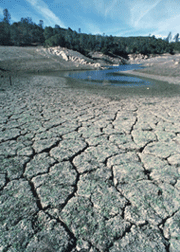
Drought conditions in New Mexico. (Courtesy of USDA)
CURWOOD: It’s Living on Earth. I’m Steve Curwood. Poor nations are at special risk from the droughts, storms and rising sea levels that are expected to result from global warming. That’s the warning contained in the latest assessment of the Intergovernmental Panel on Climate Change, made up of many of the world’s leading climate scientists.
Joining us now to discuss where and why we might see increased conflict related to global warming is Jeffrey Sachs. He is a professor at Columbia University and former director of the U.N. Millenium Project.
Hello sir!
SACHS: How are you? Good to be with you.
CURWOOD: So where in the world, what two or three areas of the world do you think are going to be hardest hit by climate change?
SACHS: I think the main message is that all parts of the world are going to be affected. And they’re going to be affected in major ways: in food production, in disease control, in risks of natural hazards like high intensity hurricanes, in changing water patterns, in vulnerability to drought and so forth.
But of course, as is so often true in life, it will be the poor and especially the poorest of the poor who are most vulnerable to these changes. For them an adverse shock often means nothing less than death.
CURWOOD: So what does this mean in terms of, well frankly, war and peace around the world?
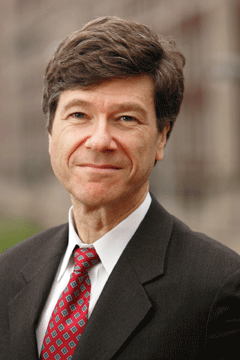
Professor Jeffrey Sachs (Photo: Bruce Gilbert)
SACHS: We already have seen in the poorest places in the world conflicts due to lack of rainfall, for example. It’s known statistically, quite powerfully, we see it before our eyes in the case of Darfur and the Horn of Africa, that when the rains fail, the wars come. Let me point out that a place like Darfur is at the core, a place suffering from extreme draught. And by the best evidence at least a part of the draught is a decline of rainfall due to man made climate change. But we’re going to see tremendous stresses in many parts of the world, and not only the poorest. Australia was hit by a mega draught, which caused a mega loss of its traditional grain exports this year. Those effected world market prices everywhere. The consequences of simply continuing on the path that we’re on is enormous risk that different countries will be pushed over the edge, that the living standards of those above the margin will suffer and that always causes political conflict. And those living on the edge of survival will be pushed right over the edge.
CURWOOD: What about the question of refugees. Whether it’s drought that forces people off the land, or rising sea levels, or catastrophic storms, people are going to find that home isn’t so hospitable any more and want to go someplace else. That’s sure to lead to conflict I would think.
SACHS: We’re going to see tremendous pressures of mass coastal populations trying to move inland, but where? We also see it in people moving out of draught stricken regions. In Africa you see the land-locked countries sending populations to the coastal economies. And when those new populations come in there are massive clashes of politics that often trigger mass violence. This is one of the things that happened in Cote d’Ivoire in the Ivory Coast. We’re also seeing of course lots of refugee movement around the Darfur crisis and the South Sudan crisis, around Somalia and in the pastoral lands of northeast Kenya. So, this is a quite pervasive phenomenon. People move to where they can stay alive. We know that there are already large water migrations taking place in India. This is the way of humanity to move when survival prospects diminish. But in a system of national boundaries and flash points of cultural conflict this obviously already does trigger violence and could potentially trigger a lot more.
CURWOOD: I want to look at China for a moment here. It’s growing economically rapidly but also the Gobi Dessert north of it is growing rapidly and moving south. There’s a water squeeze, there’s a people squeeze. They have high demand for energy. What will happen in China as the effects of climate change crank into the ecology and should we say the economy?
SACHS: China is the perfect exemplar where these issues of sustainable development could never be considered to be second tier say behind, say the economy. They are part and parcel of China’s very development challenge. If there is one risk for China’s long term growth it actually won’t be politics in my view, it is going to be the environment. Will there be a way to live sustainably where you have 20 percent of the world’s population but you have about six to seven percent of the world’s arable land and a similar proportion of access to water resources.
In northern China you have a traditionally dry area that is going to be tremendously hit by the depletion of ground water because it’s been over pumped. And those water stresses are leading to massive bewildering plans of diverting huge water systems from the south of China, the Yangtze, and other water systems up through the North in giant canals with no doubt enormous ecological consequences. And in the north the great Yellow River often no longer runs to the sea. Add on top of that the problems of snow melt, precipitation change, glacier disappearance and so forth and the water challenges in China become absolutely a first tier question for China’s long term economic development. I know the leaders are very much concerned about this. There are not easy answers right now, but it is one of the reasons why, in my view, China will come to the negotiating table and be a lead participant in the long term solution to climate change. They simply have to do it.
CURWOOD: You sound very optimistic.
SACHS: I am optimistic. I’m optimistic because the drama that we’re in is so stark the costs of inaction are so great and yet the costs of real solutions are so modest relative to the risks of doing nothing. If we’d simply flipped our way of thinking and stopped seeing this as a war of us versus them, but a challenge in which we’re all on the same side facing common ecological challenges, we’d find a tremendous camaraderie in fact that could easily be developed and that would be crucial in finding the deeper solutions to these problems.
CURWOOD: Jeffery Sachs is director of the Earth Institute at Columbia University. Thank you sir.
SACHS: Great to be with you. Thank you very much.
[MUSIC: Amon Tobin “Horsefish” from ‘Foley Room’ (Ninja Tune - 2007)]
Related links:
- To listen to host Steve Curwood's conversation with Thomas Homer-Dixon, click here.
- IPCC Working Group II: Climate Change Impacts, Adaptation and Vulnerability
- Outline for the IPCC Working Group II Contribution to the Fourth Assessment Report
- Jeffrey Sach's webpage
- Thomas Homer-Dixon's website
Sonic Sculptures
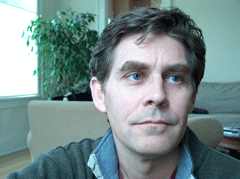
Steve Peters (Courtesy of Steve Peters)
CURWOOD: This month, this Earth month, Living on Earth is taking a listen back to some of the award-winning stories that have been heard on these broadcasts over the past sixteen years,
And today we start with a piece about a sound sculptor for whom it seems that anything can be music to his ears. We first heard from sonic artist Steve Peters in 2002, when producer Paul Ingles brought one of Peters' environmental sound sculptures to the radio.
Peters spent hours recording in an outdoor space in New Mexico called "The Land," taking care to capture sounds of nature that normally escape our attention. The broadcast segment won an Edward R. Murrow Award from the Radio and Television News Directors Association.
Steve Peters’ latest audio installation is up this month at the College of Santa Fé_in New Mexico. We’ll hear about that and his other recent work in a few minutes. But first, let’s dial up the way back machine for a listen to Paul Ingles’ 2002 piece on Steve Peters’ work called "Here-ings".
[BIRD SOUNDS UNDER]
PETERS: The land is located about an hour and a half drive southeast of Albuquerque, New Mexico in the eastern foothills of the Monzano Mountains. It's a 40-acre site. But there's 14 acres of it that they use as a work site and exhibition space for environmental art and, specifically, low-impact environmental art.
[DOVES COOING]
PETERS: I was just so impressed by how still it was and quiet. And what happened was that, because it was so quiet, every little sound that happened really stood out. You really noticed it. And all of the sounds had this kind of delicate, hushed quality that I'm a real sucker for anyway.
So, what happens, if I commit myself to coming here for a year, a couple of times a month, and sitting and doing nothing more for an hour at a time than listening to what's going on here?

Steve Peters (Courtesy of Steve Peters)
[JUNIPER BRANCHES MOVING]
PETERS: Each time I would go and spend this time listening to this place, I would make a recording of that hour. I stretched a whole day out over a year. I made 24-hour cycle of recordings over the course of one year. What I did with all those 24 hours of recordings was to edit each hour down to about five minutes or so.
[TRAIN SOUND, THEN GRASSHOPPERS, THEN WIND BLOWING THROUGH CACTUS]
PETERS: This is the sound of a chollo cactus. Chollo cactuses are these kind of long, spindly things. And when they die, they leave these beautiful kind of sculptural shapes, like long tubes with little long holes in them, and they're hollow. So this is a chollo cactus with a contact microphone attached to it on a windy day. And you're hearing the wind sort of whistling through the holes in this dead cactus.
[WIND THROUGH CACTUS, THEN TO SCREECHING SOUND]
PETERS: This here was probably the most sensational sound in the whole show. I had set a contact microphone outside the entrance to an anthill of these large, red, I think, harvesting ants. And, a couple of scouts came out and investigated, and they walked around on it. And then they went back and got a whole bunch more ants. And they all came out and swarmed on the contact microphone and started chewing on it. And then they started making these sounds, which I later learned are called "strigulation" where they sort of have like a rub board on their thorax and their abdomen or something. And they rub it together and make this little shrieking noise. It was slightly terrifying. I thought, "Okay. I think I better go now."
[ANTS SHREIKING, THEN TO THUNDERSTORM, THEN TO GRASS BLOWING AGAINST WIRE FENCE]
PETERS: This is the sound of a wire fence that runs around the perimeter of the property. And that's kind of an interesting story because I thought this fence was such an insult to the landscape in a way. I'd sit there and go, "You know, the land on this side of it isn't any different than the land on the other side. And what's this thing doing here. It's just ugly and stupid."
And then one day, I was out there, and it was really windy. And I put my ear up to one of the fence posts, and it was the most beautiful sound.
[FENCE SOUNDS]
The wind was blowing these stalks of grass against the lower strand of the wire fence.
[BIRD CAWS AND OTHERS]
PETERS: You don't get a sense of the beauty of the place from a quick scan. You really have to slow down and be with it and accept it on its own terms. And I think that's a really good lesson for all of us to carry over to all sorts of other areas in our lives.
[MUSIC UP AND UNDER: LITHOPS, "UNI UMIT #4," UNI UMIT, MOIKAI, 1997]
CURWOOD: Since Paul Ingles produced that award winning story for Living on Earth, Steve Peters has moved to Seattle where he continues to find and remix unexpected sounds into aural sculptures, including this one, called “Morning Ragas.”
[Steve Peters “Morning Ragas” from ‘Soundwalk at Port Angeles Fine Arts Center’ (Port Angeles, WA – Summer 2005)]
CURWOOD: He also appears sometimes appears in the group called Phonographers Union.
PETERS: What happens at a phonographers concert is who ever shows up is the group for that night and it’s usually somewhere between eight and 12 people. And we all have either personal CD players or laptops or iPods loaded with recordings that we’ve all been making on our own and then we perform live improvising sound collages with untreated field recordings.
[Steve Peters & Seattle Phonographers Union “Excerpt 1” from ‘Building 27 Sand Point, Magnuson Park’ (September 22nd & 23rd, 2006)]
PETERS: I’m pretty fascinated with the idea of kind of managing to pull something out of nothing. And then I’ve also continued to do site specific sound installations in various places. At the moment I have one at the College of Santa Fe in Santa Fe, New Mexico.
[Steve Peters & Christine Wallers “First Light, Last” from ‘Sound & Video Installation at Portland Art Center’ (Portland, WA – December 2006)]
PETERS: Openings for my work tend to be kind of a horrible experience because everybody is being festive and drinking wine and talking and laughing and my little quiet, barely-audible pieces tend to get crushed. (laughs) Everybody is always saying “Can’t you turn it up? Turn it up” And I’m saying, “No I’m sorry. Come back some time when it’s not the opening.”
CURWOOD: Sonic sculptor Steve Peters latest work "Atrium Sound Space" can be seen and heard on our web site L-O-E dot O-R-G.
Related links:
- Steve Peters' blogspot
- Seattle Phonographers Union
CURWOOD: Next week on Living on Earth: keeping an eye on endangered marine mammals from the air. The job can bring some remarkable rewards.
LANHAM: Sometimes you drop down so low, all the spout, the blow of the whale drifted through the open window. I mean we were literally wiping a blue whale’s breath off our faces!
CURWOOD: Catching up with Mexico’s “eco pilot” next time, on Living on Earth.
[“Phonographers Union (untitled excerpt)” recorded by Steve Peters from ‘Live on Sonarchy Radio’ (Accretions Records – 2003)]
CURWOOD: We leave you this week with more of the sonic sculpture of sound artist Steve Peters.
[“Phonographers Union (untitled excerpt)” recorded by Steve Peters from ‘Live on Sonarchy Radio’ (Accretions Records – 2003)]
CURWOOD: Living on Earth is produced by the World Media Foundation. Our crew includes Ashley Ahearn, Eileen Bolinsky, Bruce Gellerman, Ian Gray, Ingrid Lobet, Jennifer Percy, Emily Taylor, Peter Thomson and Jeff Young - with help from Bobby Bascomb, Kelley Cronin and Jeff Turton. Our interns are Paige Doughty and Meghan Vigeant. Dennis Foley is our technical director. Alison Lirish Dean composed our themes. You can find us any time at loe dot org. I’m Steve Curwood. Thanks for listening.
ANNOUNCER: Funding for Living on Earth comes from the National Science Foundation, supporting coverage of emerging science; And Stonyfield Farm; Organic yogurt, smoothies and milk. Ten percent of profits are donated to efforts that help protect and restore the earth. Details at Stonyfield dot com.
Support also comes from you our listeners, the Ford Foundation, the Geraldine R. Dodge Foundation, and the Saunders Hotel Group of Boston’s Lennox and Copley Square Hotels. Serving you and the environment while helping preserve the past and protect the future, 800-225-7676.
ANNOUNCER2: PRI, Public Radio International.
Living on Earth wants to hear from you!
Living on Earth
62 Calef Highway, Suite 212
Lee, NH 03861
Telephone: 617-287-4121
E-mail: comments@loe.org
Newsletter [Click here]
Donate to Living on Earth!
Living on Earth is an independent media program and relies entirely on contributions from listeners and institutions supporting public service. Please donate now to preserve an independent environmental voice.
NewsletterLiving on Earth offers a weekly delivery of the show's rundown to your mailbox. Sign up for our newsletter today!
 Sailors For The Sea: Be the change you want to sea.
Sailors For The Sea: Be the change you want to sea.
 The Grantham Foundation for the Protection of the Environment: Committed to protecting and improving the health of the global environment.
The Grantham Foundation for the Protection of the Environment: Committed to protecting and improving the health of the global environment.
 Contribute to Living on Earth and receive, as our gift to you, an archival print of one of Mark Seth Lender's extraordinary wildlife photographs. Follow the link to see Mark's current collection of photographs.
Contribute to Living on Earth and receive, as our gift to you, an archival print of one of Mark Seth Lender's extraordinary wildlife photographs. Follow the link to see Mark's current collection of photographs.
 Buy a signed copy of Mark Seth Lender's book Smeagull the Seagull & support Living on Earth
Buy a signed copy of Mark Seth Lender's book Smeagull the Seagull & support Living on Earth

